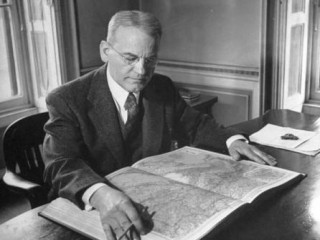
Isaiah Bowman biography
Date of birth : 1878-12-26
Date of death : 1950-01-06
Birthplace : Waterloo, Ontario, Canada
Nationality : Canadian
Category : Arhitecture and Engineering
Last modified : 2011-07-01
Credited as : Geographer, Forest Physiography, The Andes of Southern Peru , American Geographical Society
Geographer Isaiah Bowman was born at Waterloo, Ontario, Canada, on Dec. 26, 1878. At the age of 18 he became a teacher in a rural school. His immense ability was noted by the geographer Mark Jefferson, who offered Bowman a post at the Normal College in Ypsilanti, Mich., provided that he went to study in an eastern university. He had the good fortune to study at Harvard under the geographer William M. Davis.
On Bowman's graduation in 1905, Yale University offered him a post as instructor in the department of geology. There he remained for 10 years, teaching geography on modern lines, during which time he made three expeditions to South America (1907, 1911, and 1913). He published two scholarly works about these trips: The Andes of Southern Peru (1916) and Desert Trails of Atacama (1924). His first book, Forest Physiography (1911), shows that he already had a deep knowledge of physical geography in all its aspects.
In 1916 Bowman became director of the American Geographical Society. Under his direction the Geographical Review, replacing the earlier bulletins, became a model of good looks as well as a mine of scholarship. Several major monographs were issued, including his The Pioneer Fringe (1931) and a cognate volume prepared under his direction, Limits of Land Settlement (1937). But the book that delighted generations of geographers is Bowman's The New World: Problems in Political Geography, published in 1921 and reprinted many times. Part of its interest lies in Bowman's work as chief territorial specialist of the American delegation to the Paris Peace Conference in 1918-1919, though the book was not based solely on the experiences of that time but on the vast knowledge accumulated in previous years, including those when the American Geographical Society had housed the "Inquiry, " a research team of 150 workers.
Bowman resigned as director of the American Geographical Society in 1935 to become president of Johns Hopkins University. He served on numerous commissions, especially those concerned with international questions, and was an adviser on the plans to set up the United Nations. The full range of his activities, especially as an adviser to President Roosevelt and others, will probably not be revealed until his private diaries and files are opened. Bowman died in Baltimore on Jan. 6, 1950.
During his life he broadened the scope of geography, encouraged graduate schools, and made the American Geographical Society a world institution. Bowman belonged not only to the United States but to the international community working for peace.
















